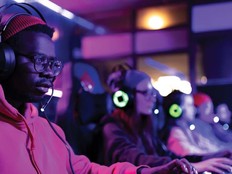Virtual Esports Will Continue into the New School Year
For Ben Fernquist, a cadet going into his senior year at the academy, the online communications platform Discord helped make remote practice and competition possible. “In the spring, I was lucky enough to be on the first roster that we had playing Rainbow Six Siege,” he says.
“We started off playing in a room together, using Discord to communicate,” he says. Then the students went home. “Since we already used the Discord server to communicate, transitioning to the remote setting was really easy for us. With modern technology and modern internet, everything is almost the same.”
The military academy is taking a phased approach this fall. Although some students have returned to campus, gamers will continue to compete virtually. Five captains will head teams in games including Valorant and Call of Duty, military-style games that aim to develop traits like leadership and collaboration.
Such games are a good fit, given the West Point mission. “In the game, when the bullets are flying and the explosions are going off, we have to make those same critical decisions that we will have to make as future leaders,” Fernquist says.
At home, Jones plays on a customized Lenovo machine with a GTX 960 graphics card and an i5 processor. “It’s a basic desktop that I put a graphics card in,” he says.
From a technology perspective, “it’s nowhere near what we were competing on at school, but it played relatively the same for me,” he says. “We did have some issues with connectivity. We had people all around the country who couldn’t connect to servers. That was the biggest issue, the internet connectivity.”
MORE ON EDTECH: See why COVID is not stopping esports.
Physical Game Spaces Adapt to the Pandemic
The team aspect of play also took a bit of a hit in the virtual gaming environment.
“When you are all in the same room together, you can look over your shoulder, you can pat your buddy on the back when he does something cool,” Fernquist says. “But even when we play remotely, we all have headsets on and we communicate through Discord, so that team aspect stays pretty strong.”
Despite the potential hurdles, Castro says the team is ready to play competitively, whatever the fall semester may bring.
As a hedge against a possible return to socially distanced team play, attendance at the 50-person game space on campus now is capped at 18 people.
“We have them in stations with four computers to an island, and we will only put one player on an island, and each island is separated from the next by 6 feet,” Castro says.
In addition to this main space, the club uses a separate room with just five gaming stations, where it would be possible to support an eventual return to in-person competition.
“They can play there with safe distancing, and there are other advantages,” Castro says. “The communication between the players in that room is great, and there are no external distractions.”
READ MORE: Learn how Intel is helping universities expand their esports impact.
Jones says that extra play space makes him comfortable with the prospect of an eventual return to on-campus play. “It’s just us five competing in that room, with people watching the stream in the common room,” he says. “Now, with COVID, it just gives us a level of safety and comfort.”
In the meantime, the team will rely on a range of supporting technologies to keep players up and running for as long as the play-from-home period lasts.
“We will have to depend on a variety of software platforms to keep everybody connected, engines like Battle.net or Steam or Origin or Activision,” Castro says. “Students will log in to those accounts and connect with students anywhere in the world. We’ll meet in the ‘lobby’ and go off and compete against other teams.”
Competitions will be broadcast on the Twitch platform, which has been a big draw for supporters of West Point esports. Castro says the team’s channel had 1.2 million views over five months in early 2020, with as many as 18,000 people watching at any given time.
For an institution like West Point, esports have proved to be a natural fit. “The academy is always looking for different ways to enhance the cadet experience,” Castro says.
“Everyone plays an intramural sport, and esports brings a new dynamic. It’s something challenging that the kids already enjoy,” he says. With its emphasis on leadership, teamwork and competitiveness, esports helps to promote one of the military school’s core messages, “the culture of winning with honor.”










